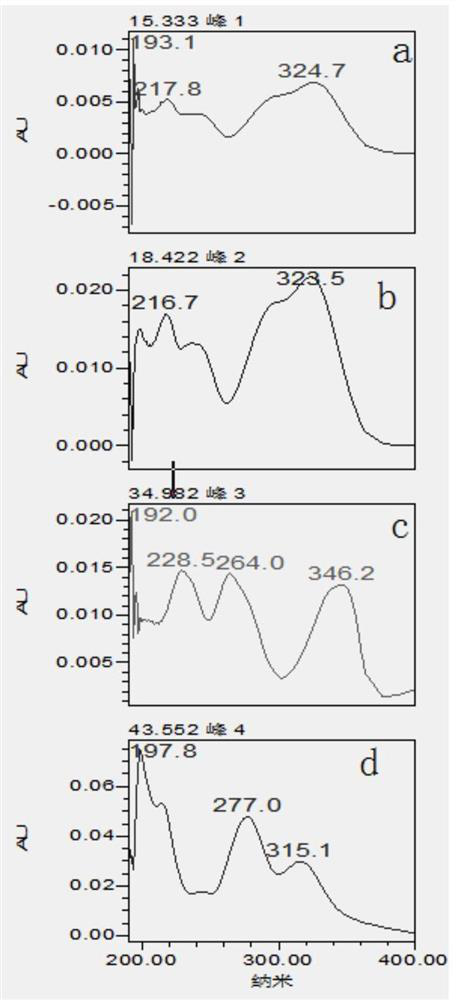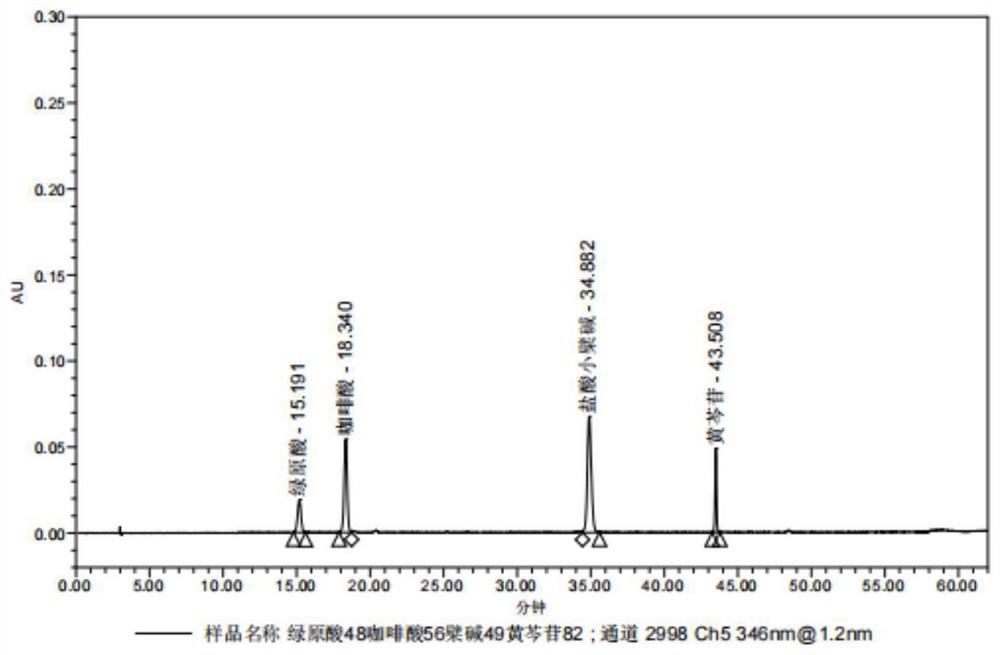Method for simultaneously determining four effective components in Gongying Qinglan granules
A technology of active ingredients and determination methods, which is applied in the field of simultaneous determination of four active ingredients in Gongying Qinglan Granules, can solve the problems of inability to detect active ingredients at the same time, complicated preparation of thin-layer chromatography, and difficult identification of thin-layer spots, and achieve chromatographic peaks The effect of good peak shape, good reproducibility of results, and moderate peak area response
- Summary
- Abstract
- Description
- Claims
- Application Information
AI Technical Summary
Problems solved by technology
Method used
Image
Examples
Embodiment 1
[0084] Simultaneous determination method of 4 active ingredients in Gongying Qinglan Granules. The 4 active ingredients are chlorogenic acid, caffeic acid, berberine hydrochloride, and baicalin. The assay method includes the following steps:
[0085] a. Preparation of standard stock solution and mixed standard stock solution
[0086] Take standard products of chlorogenic acid, caffeic acid, baicalin, and berberine hydrochloride, dissolve them in methanol and make up to volume, and prepare chlorogenic acid standard stock solution, caffeic acid standard stock solution, baicalin standard stock solution, and berberine hydrochloride Alkali standard stock solution; each standard stock solution is mixed to obtain a mixed standard stock solution, see Table 3 below for details:
[0087] table 3
[0088]
[0089] b. Preparation of sample solution to be tested: Accurately weigh 1.0g of Gongyingqinglan granules for testing, place in a 25mL volumetric flask, dissolve with 70% ethanol a...
Embodiment 2
[0110] Simultaneous determination of 4 active ingredients in the Gongyingqinglan granule described in Example 1, the difference is:
[0111] In step b, prepare the sample solution to be tested: Accurately weigh 2.0 g of Gongyingqinglan granules as the test product, place it in a 50 mL volumetric flask, dissolve it with 70% ethanol and set the volume to the mark, extract 10 ml from it by ultrasonic extraction for 30 min, 10000 rpm / min centrifugal 5min, filter, and the filtrate is determined by liquid chromatography; other conditions and steps are the same as in Example 1.
experiment example
[0113] 1. The influence of different solvent treatment methods on the test results
[0114] Compare the impact of different solvent treatment methods on the test results. In step b, the sample solution to be tested is prepared from method A, method B or method C in table 5, method D, method E, method F, method G, method H, method , Method I, Method J.
[0115] table 5
[0116] serial number method Different Solvent Treatment Methods 1 Method A 70% ethanol:hydrochloric acid=100:0.5 2 Method B water 3 Method C 50% methanol 4 Method D (100 methanol: 1 hydrochloric acid): water = 1:1 5 Method E 5% methanol 6 Method F 50% ethanol 7 Method G (100 methanol: 5 hydrochloric acid): water = 1:1 8 Method H Absolute ethanol 9 Method I Methanol 10 Method J Methanol: hydrochloric acid = 100:1 11 Method K 70% ethanol
[0117] specific:
[0118] Method A is: accurately weigh 1.0 g of the...
PUM
| Property | Measurement | Unit |
|---|---|---|
| particle diameter | aaaaa | aaaaa |
| particle diameter | aaaaa | aaaaa |
| particle diameter | aaaaa | aaaaa |
Abstract
Description
Claims
Application Information
 Login to View More
Login to View More - R&D
- Intellectual Property
- Life Sciences
- Materials
- Tech Scout
- Unparalleled Data Quality
- Higher Quality Content
- 60% Fewer Hallucinations
Browse by: Latest US Patents, China's latest patents, Technical Efficacy Thesaurus, Application Domain, Technology Topic, Popular Technical Reports.
© 2025 PatSnap. All rights reserved.Legal|Privacy policy|Modern Slavery Act Transparency Statement|Sitemap|About US| Contact US: help@patsnap.com



